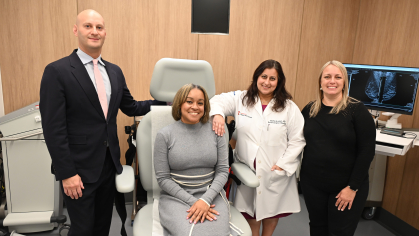Low Pay Is Driving Primary-Care Doctors From New Jersey, Endangering State Residents

A shortage of primary-care doctors endangers United States residents in general and New Jerseyans in particular, according to a report co-authored by Alfred Tallia, chair of the Department of Family Medicine and Community Health at Rutgers Robert Wood Johnson Medical School.
“Anyone who has tried to schedule a nonemergency visit understands the problem,” said Tallia, one of 16 experts who contributed to the New Jersey Health Care Quality Institute's report. “Existing patients often wait months; others struggle to find a doctor who’s even taking new patients. Lots of people get no care until small problems grow into emergencies.”
“Most of this problem stems from money,” added Tallia. “Primary-care doctors make way less than specialists across the U.S., so we have too few primary-care doctors relative to the number of specialists. Primary-care doctors make even less in New Jersey than in other states, so the ones we train here tend to move elsewhere, and the shortage is worse in New Jersey than in other states.”
Primary care has been proven to reduce mortality, serious health conditions, population health disparities, and health care costs, Tallia said, yet it remains underfunded, particularly in New Jersey.
According to the report — Primary Care in New Jersey: Findings and Recommendations to Support Advanced Primary Care — slightly less than a third of practicing physicians in the U.S. provide primary care, compared with more than half of physicians in the 38 countries that make up the Organization for Economic Cooperation and Development (OECD). The share of U.S. health care spending devoted to primary care declined from 6.5 percent of total health spending in 2002 to 5.4 percent in 2016 to 4.6 percent in 2020, while such spending remains 7.8 percent or more in other OECD countries.
New Jersey, in turn, underspends on primary care compared with other states. New Jersey Medicaid pays primary-care doctors half of what Medicare pays. Commercial insurers — who pay primary-care providers an average of 120 percent of Medicare rates nationwide — pay an average of 93 percent of Medicare rates in New Jersey. Some small New Jersey practices with little leverage to negotiate higher reimbursement with insurance companies receive 75 percent of Medicare rates. In fact, New Jersey ranks 48th out of the 50 states in primary care spending.
Lower pay leads many primary-care doctors who train in New Jersey to leave the state. New Jersey ranks 10th nationally in primary-care residents and fellows but is 32nd nationally in retaining those people after they complete their training.
According to 2023 survey data from the state Board of Medical Examiners, New Jersey has about 5,300 doctors in the primary-care fields of family medicine, general internal medicine and geriatrics. But half of them work full-time.
The report, authored by a panel of health care providers and insurers convened by the quality institute, recommends three major steps to end the shortage and help New Jersey residents gain easy access to primary care that should help them live longer and healthier lives.
The state should:
- Raise Medicaid reimbursement rates for primary care to Medicare levels and direct Medicaid Managed Care Organizations to do likewise.
- Use its regulatory power to begin shifting doctor compensation from the historical fee-for-service model and toward an advanced primary-care model, where doctors get money to keep patients well rather than simply treating them when they are sick.
- Better track caregiver numbers and medical expenditures and use the data to track improvements.
Tallia said the effort to move from fee-for-service to advanced primary care echoes a major national report authored by a group that included Rutgers Health Vice Chancellor Shawna Hudson that aims to extend U.S. lives “by bringing our primary care practices into line with those in countries where people are much healthier than they are here.”
“The other recommendations are New Jersey specific, and they can ease the worst of the problems here in New Jersey,” Tallia added. “We’ve seen several other states, including Oregon, Massachusetts and Rhode Island, work to ease major primary care shortages by adjusting rates.”


